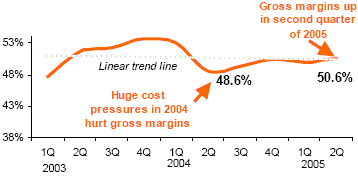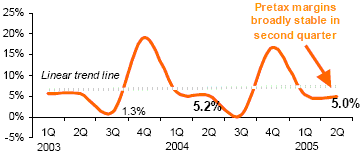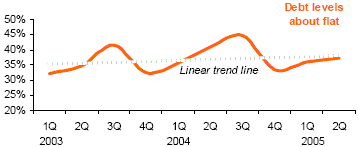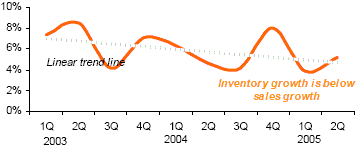IDEX Online Research: Jewelers’ Profits Solid in Q2; Financial Trends Positive
October 13, 05
Jewelry merchants can breathe a sigh of relief: gross profits have risen this year. Last year’s surging costs relented in the first half of 2005. As a result, U.S. jewelry retailers reported improved gross margins and stable pretax margins. As a further sign of improving financials, merchants’ debt levels have remained about flat and inventory gains are below sales increases.
Beyond the U.S. market, IDEX research believes retail jewelers worldwide have also benefited from improving financials. As a result, merchants are well-prepared – financially, at least – for the upcoming holiday selling season. With only a few exceptions, jewelry suppliers and diamantaires should feel more confident about their ability to collect on extended payment terms and amounts due from memo goods.
Gross Margins – Rising
For jewelers, this year’s rising gross margins are the best news since Santa Claus. In 2004, diamond prices surged, gold soared, and platinum spiked. Through the first half of 2005, commodity price increases have moderated. Despite two rough diamond price increases initiated by the DTC, polished prices were more stable. In the second quarter, the IDEX Index of Polished Diamond Prices rose by a very modest 1% over the same period in 2004. Gold rose 10% year-over-year in U.S. dollars, but only increased 5% in Euros; gold lease rates were essentially flat. Platinum rose a modest 6%. Silver prices were up 20%, but at about $7 per ounce, silver prices don’t have a major impact on retailers’ costs. As a result of reduced cost pressures, the typical U.S. chain jeweler posted a second quarter (2005) gross margin which was 200 basis points (two percentage points) higher than the prior year, as the graph illustrates.
| Composite Gross Margin Trends |
Key components of public companies’ gross margin generally include product costs as well as buying, occupancy, and other costs. Gross margin is calculated by dividing gross profit (sales less cost of sales) by revenues.
Publicly held jewelers cited the following factors that have affected their gross margins this year:
- Sales mix – For most jewelers, mix was a negative because of greater sales of large diamonds which have an inherently lower margin. On the other hand, these sales generated substantially greater gross profit dollars, and they reflect the industry’s success with creating bigger ticket sales. Further, despite seesawing consumer confidence, shoppers once again proved that they will buy larger, better quality stones, when offered the chance.
- Supply chain efficiencies – These are code words for at least two factors:
- Better vendor negotiations – Retailers continue to squeeze vendors for better prices. As a result, suppliers’ margins have been declining. Unfortunately, the jewelry industry is so fragmented that if one vendor won’t chop prices, there are ten more knocking on the retailer’s door offering better deals.
- More direct buying – Among the majors, Kay has been the leader in implementing direct-buying from overseas manufacturers. Now, Zale has begun buying direct, a move which management says will yield 40-50 basis points of margin improvement annually for the next several years. Some wholesalers to Zale will need to find new retail customers or create new ways to add value, if they want to stay in business.
- Higher retail prices – Most jewelers complained that surging commodity costs in 2004 came too rapidly for them to raise retail prices enough to absorb the higher costs. This year, almost every retailer mentioned that they had raised retail prices.
- Add-ons – Sales people at many retail jewelers have been more aggressive with add-on purchases such as “extended service protection” plans and other high margin programs.
Operating Costs - Up
Operating costs were up modestly in the second quarter. Operating costs generally include selling, general & administrative expense, depreciation, and interest expense – basically all remaining costs which are not included in the gross profit calculation.
Jewelers cited the following factors which affected their operating cost ratio (operating costs divided by revenues):
- Sales leverage – For most chain jewelers, this was a positive factor. When sales are strong, relatively fixed overhead costs are efficiently absorbed. Most chain jewelers reported solid sales gains, but smaller independent jewelers’ sales gains were more modest and may have de-leveraged costs, resulting in a reduced operating margin.
- Marketing & advertising – Some jewelers reported higher marketing costs; others reported a decline (as a percentage of sales). For example, Finlay reported lower advertising costs, but Zale and Tiffany reported significant increases. Blue Nile says it will increase its advertising expenditures from about 4% of sales to about 4.5% in an effort to take more market share. Odimo reports that its marketing costs have risen significantly.
- Credit costs – While Sterling reported that its bad debt costs rose modestly (probably related to consumers opting for bankruptcy prior to implementation of new tougher laws), Zale reported that its proprietary credit card cost ratio declined.
- Public company costs – Almost every public company complained about the costs related to Sarbanes-Oxley requirements.
- Payroll – We did not hear as much chatter about rising labor costs as in the past.
Pretax Margin – Stable
While gross margins rose solidly in the second quarter, a majority of merchants also reported an increase in their operating cost ratio. Thus, jewelers’ pretax margins were broadly stable in the second quarter, as the graph illustrates.
| Composite Pretax Margin Trends |
Balance Sheets – Solid
Two other encouraging trends emerged in the second quarter: jewelers’ debt levels remained steady and inventory growth moderated. In part, you could argue that these two factors go hand-in-hand. To a point, they do. But far too often, jewelers rely on their banks as their equity partners by taking on too much debt.
- Debt levels are reasonable – The publicly held jewelers have about $1 of debt to every $2 of equity. By any standards, this is a reasonable – and relatively conservative – level of debt.
If interest rates rise sharply, interest costs can soar, cutting into profits. Most jewelers have refinanced their long term debt at favorable rates; this leaves them in good shape, as the Fed continues to raise interest rates.
| Composite Debt Levels |
- Inventory growth moderated – Inventory growth in the second quarter rose by about 5%, somewhat less than the total sales gain of just over 6%. Theoretically, this means that inventory turns should pick up. It is still to early to see if this will happen, but at least the stage is set. It is also too early to get a reading on holiday inventory levels; we’ll need to wait until third quarter numbers are available (sometime in late November or early December, by which time they won’t mean much to us).
| Composite Inventory Growth |
The only sore spot in the American market is Whitehall Jewellers. Whitehall has taken a one-two-three punch that could pummel it into bankruptcy protection. First, it has failed to file its financials with the Securities & Exchange Commission on a timely basis (this is never a good sign, and usually means that unsettling news is coming). Second, it hired and then lost a high profile CEO – Beryl Raff – who likely could have turned the company round. And, third, Whitehall’s lead lender has just sent a default letter to the company.
Your Results
IDEX Research recommends that retail jewelers use these financial benchmarks to measure their own performance. Members of IDEX can contact IDEX Research at research at idexonline. com for information about how to compare their own performance with the IDEX indices. All requests will be handled personally and confidentially.
You are also invited to answer our online poll located at the bottom right of the IDEX homepage: How was your second quarter compared to last year?



